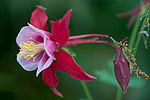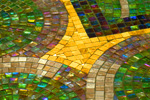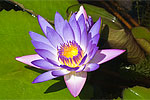Best Superzoom Cameras under $500
ALSO RAN:
FujiFilm Finepix HS30EXR
When you pull the FujiFilm HS30 EXR from the box, the first impression is that it has a solid, professional feel that is a step above the other half dozen superzoom cameras in its price class, all of which are a bit smaller and lighter. It looks and feels more like a DSLR than a superzoom bridge camera. That first impression led us to expect great things from it. Unfortunately, this was not to be. After extensive side-by-side shooting against the Panasonic DMC-FZ150 and the new Nikon P510, the Fuji HS30 rather consistently brought up the rear in terms of picture quality. No matter what adjustments we made to, the HS30 was usually not able to render a photograph as sharp and clean as the competition.
FujiFilm Finepix HS30EXR
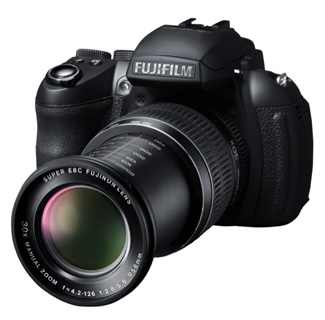 |
What's HOT about the Fujifilm HS30 EXR:
1. Very good electronic viewfinder, matches the Sony HX100V as the best overall in the superzoom group
2. Manual zoom, much faster and more precise when shooting still images than power zooms in this class
3. 24mm to 720mm zoom range
4. Bright hi res LCD screen, 920,000 dots, articulates vertically
5. Manual focus optional if you want to activate it
6. Feels more substantial, more "professional" than most superzooms
7. Proximity sensor, auto activates viewfinder or LCD screen depending on what you are looking at (why doesn't the Nikon P510 have this??)
8. Hot-shoe, some superzooms don't have one
9. 360 degree panorama mode
10. 3D photos
11. Captures RAW files
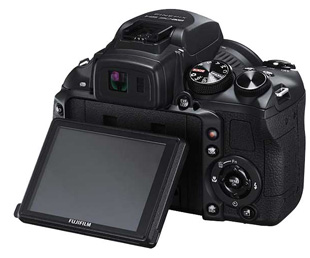 |
What's NOT so hot about the Fujifilm HS30 EXR:
1. Soft focus on too many shots
2. Excessively noisy images at moderate to high ISOs
3. Manual zoom good for still shots but bad for video--very clumsy, jerky control of the image
4. Bigger, heavier than other superzooms (weighs 1/3 more than the Panasonic FZ150)
5. Pink hue in viewfinder
6. Clumsy EV adjustment control
7. No input for external mic
8. Tends to overexpose, but setting to -0.3 EV causes it to underexpose too frequently
9. When hand-holding the camera at max telephoto, the image in viewfinder or on LCD is unstable-harder to frame the shot precisely compared to the Panasonic FZ150 or the Nikon P510.
10. Poor focus in video mode at telephoto end of the zoom
11. Slow continuous focus in video mode-scene goes in and out of focus as you change zoom
12. Poor focus in burst mode
13. 30 sec max shutter speed works only at 100 ISO. As you increase ISO each full stop, max shutter speed drops by 50%.
14. The digital noise may prompt selection of high noise reduction, but high noise reduction obliterates picture detail.
15. Three sharpness settings: "Soft" is too blurry, "Hard" is too noisy, so "Standard" is the only practical option.
A Look at the FujiFilm Finepix HS30 EXR
Manual zoom lens-the good and the bad. Perhaps the single biggest difference between the Fuji HS30 EXR and all other superzoom cameras in this shootout is its manual zoom lens-all of the others have power zooms. This can be either an appealing advantage or a serious detriment depending on what type of shooting you do. For still photo images, the manual zoom is much faster to run from wide to telephoto, and it is easier to hit precisely the amount of zoom required to frame the image. Power zooms are slower to get from A to B, and they are sometimes finicky when you try to hit a precise zoom point. So you end up overshooting, and having to reverse and zero in on the ideal frame. So for sequential still photos, the Fuji HS30's manual zoom provides for much more rapid and accurate response in the hands than pretty much any of the power zooms on the other cameras in this group.
However, for video/movie use, that manual zoom lens becomes the worst of the HS30's features. It takes a great deal of practice to manipulate the manual zoom without jerking and shaking the camera during a video shoot. Meanwhile, the power zoom on the Panasonic FZ150 or the Nikon P510 provide slow, controlled, smooth articulations of the zoom range resulting in more professional looking video. In addition, the continuous autofocus on the FZ150 in particular is robust enough to keep the subject in focus throughout the entire zoom range, and it remains in focus as the zoom range changes. On the HS30, not only does the manual zoom itself contribute to jerky and unstable video, the continuous autofocus on the HS30 is always a few beats behind, causing the image to go in and out of focus with each change in the zoom setting. And when the lens is at maximum zoom it takes a long time to find focus, if it ever finds focus. On top of all that, the Panasonic FZ150 will accommodate an external mic for substantially better audio and the HS30 can't do that either. So if you are looking for a camera to shoot video/movies, the HS30 is one to avoid.
 (this test image was photographed with the HS30, the FZ150, and the Nikon P510) |
If the HS30 is not for video, what about photos?
Poor video performance reduces the Fuji HS30 to consideration as a still camera only. If it was able to outperform the competition in still photos, it would have some redeeming value. Unfortunately, our test sample showed frequent soft focus problems, an extremely elevated level of digital noise in moderate to low light situations, and greater than average noise in brightly lit scenes. For any given scene that we photographed sequentially with the HS30, the Panasonic FZ150 and the Nikon P510, the HS30 tended to render the least appealing results of the three. Here is the 100% detail cropped from the HS30 and FZ150 photos:
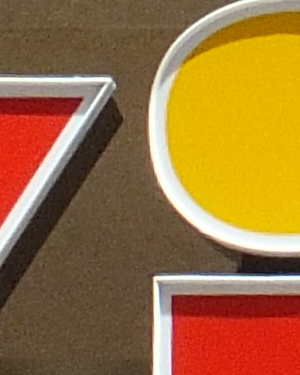
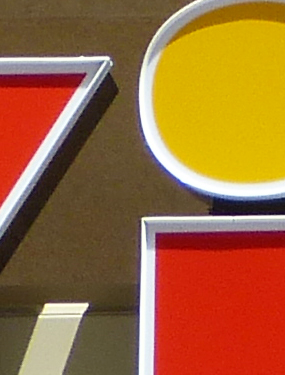
Fujifilm HS30EXR Panasonic DMC-FZ150
(Cropped detail, Kidville, 100% view)
In the comparison above, the HS30 shows higher noise level and softer focus. This result manifested itself using both EXR settings as well as Program mode. There is an option to boost noise reduction on the HS30, but it hammers detail and yields a less satisfying result. As an aside, the image on the HS30 appears closer due to the difference in pixel resolution--the HS30 is 16 MP vs. the FZ150's 12 MP.
You can see what a disaster the HS30's noise level is in this comparison between the HS30 and the Canon SX40. Move the lens to left and look and the Colman's Mustard label. These cameras are set to 100 ISO, the slowest and best exposure to minimize noise. But the HS30's noise level is simply terrible even at ISO 100. You can set the ISO levels to higher speeds on both of these cameras and see the impact.
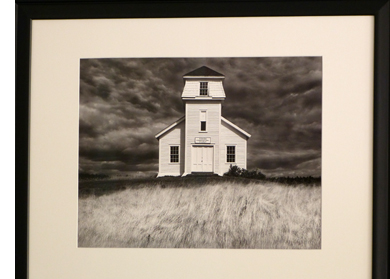 (photograph of a mounted b/w photo, taken in ambient indoor light) |
In lower light situations, excessive noise, erroneous focus, and inaccurate exposure on the HS30 would frequently combine to ruin the image entirely. The Finnish Church, a mounted photograph, was used as an indoor target for both the Fuji HS30 and the Panasonic FZ150. The cameras were both hand-held from a distance of ten feet relying upon automatic exposure defaults. As you can see, the HS30 overexposed, and the combination of noise and slight miss on the focus produced an unsuccessful image. The Panasonic FZ150 was able to capture a sharper, cleaner image with superior detail:


FujiFilm HS30 EXR Panasonic FZ150
(both cameras from 10 feet, 100% cropped section of Finnish Church above)
An unrelated shooting problem on the HS30 was that on occasion with longer zoom shots, the failure on the HS30 was due to inaccurate framing of the subject due to the instability of the image in the viewfinder or on the LCD screen. The target jumps around more in the viewfinder or on the LCD screen, making precise framing a bit of a crapshoot. We did not have this problem as much with the FZ150 or the P510. This is the least of the problems on the HS30, but still a nuisance worth mentioning.
The Verdict
The FujiFilm HS30EXR feels great in the hands, and its manual zoom lens is a plus for those who want more rapid zoom response than power zooms can provide. But ultimately, the camera did not perform well in image quality for either movies or still photos compared to the Panasonic FZ150 or the new Nikon P510.
